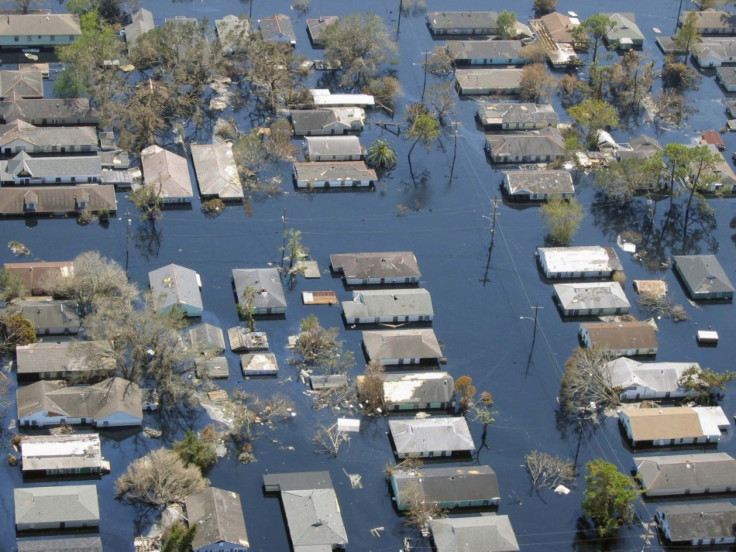Tropical Storm New Orleans: Flooding Is a Greater Threat Than Winds

Tropical Depression 13, which continued to move toward the Gulf Coast on Friday, is sparking renewed fear in a region devastated by Hurricane Katrina six years ago. At 7 a.m., it had winds up to 35 miles per hour, according to the National Hurricane Center, and it was expected to strengthen into Tropical Storm Lee later in the day. It was not, however, expected to become a full-blown hurricane.
But the region can by no means rest easy. The storm may not be packing hurricane-force winds when it hits New Orleans, as it is expected to do over the weekend, but it could drench the city with up to 20 inches of rain and cause severe flooding. Even Katrina did not bring that much rainfall to the city -- the maximum estimate is about 15 inches -- although the storm surge from Katrina was worse than the surge from the latest tropical depression is likely to be.
As the would-be Lee approaches land, it should serve as a reminder that, while high winds can be very dangerous, the majority of damage and casualties in the most devastating hurricanes tend to come from flooding, not from the winds themselves. Obviously, most Category 4 hurricanes will be more destructive than most Category 1 hurricanes, but even a tropical storm can be catastrophic when it comes to flooding.
In 2005, Hurricane Katrina made landfall on the Gulf Coast as a Category 3 storm and passed through New Orleans without initially doing the catastrophic damage that had been expected. The winds died down and New Orleans exhaled -- but the next day, the storm surge from Lake Ponchartrain overcame the levee system, and it was the resulting flooding that made Katrina one of the most devastating hurricanes ever to hit the United States.
For a more recent example, one need only look to Hurricane Irene, which was downgraded to a tropical storm by the time it reached the Northeastern states but still caused historic flooding in New Jersey and Vermont and wiped out an entire Metro-North Railroad line for months. Downed power lines and fallen trees and branches caused a lot of damage, and even some deaths, but it was the severe flooding that really crippled some areas.
Threats vary from storm to storm and are also dependent upon the location that the storm moves over, Corene Matyas, a hurricane expert and a professor in the University of Florida's geography department, told IBTimes on Friday. If the ground is already wet or if it is sloped, it takes less rainfall to cause flooding. That was certainly the case in New Jersey, where the ground was saturated from heavy rainfall in the week preceding Irene.
In addition to being potentially more severe, heavy rainfall can spread over much larger areas than the fast winds, Matyas said. The maximum sustained wind speed is a one-minute sustained wind speed usually found near the storm center, and winds of this magnitude may only occur over a localized area.
This is a serious consideration in preparing for Tropical Depression 13, or Tropical Storm Lee if and when it is upgraded. The storm, currently traveling over the Gulf of Mexico, is moving extremely slowly, according to The Weather Channel, which means it will have plenty of time to flood New Orleans with torrential rain before it passes.
There have, of course, been hurricanes that wrought terrific damage with their winds, and Matyas said it was important to remember that there can be severe damage even from winds below hurricane force. She also pointed to the Category 4 Hurricane Charley, which hit Florida in 2004. Because the storm moved very quickly, there was not a lot of time for storm surge to be produced or rainfall to accumulate, she said. Rainfall measured by rain gauges in Florida was just over five inches and storm surge reports of four feet. But in this case, the majority of damage was likely caused by the winds. Hurricane-force winds were measured as far inland as Orlando.
Clearly, high winds pose a threat that cannot be dismissed. But on a list of the very worst hurricanes, most of the devastation came from flooding. Here are the top five in terms of deaths, with the estimated maximum height of their storm surges:
1. Great Galveston Hurricane (1900), 15 feet.
2. San Felipe-Okeechobee Hurricane (1928), 9 feet.
3. Hurricane Katrina (2005), 16 feet.
4. Long Island Express (1938), 16 feet.
5. Labor Day Hurricane (1935), 20 feet.
Storm surges are, of course, caused by high winds, so it would be absurd to say that wind speeds do not play a big role in determining the severity of a hurricane. However, Category 1 or 2 hurricanes and even tropical storms have been known to bring tremendous flooding with comparatively low winds, and these storms are all the more devastating because people tend to underestimate them. There is really no such thing as only a Category 1 hurricane; if it brings a storm surge, it can cause tremendous destruction. It is crucial to focus more on the effects of flooding and less on wind speeds in a vacuum.
© Copyright IBTimes 2024. All rights reserved.





















